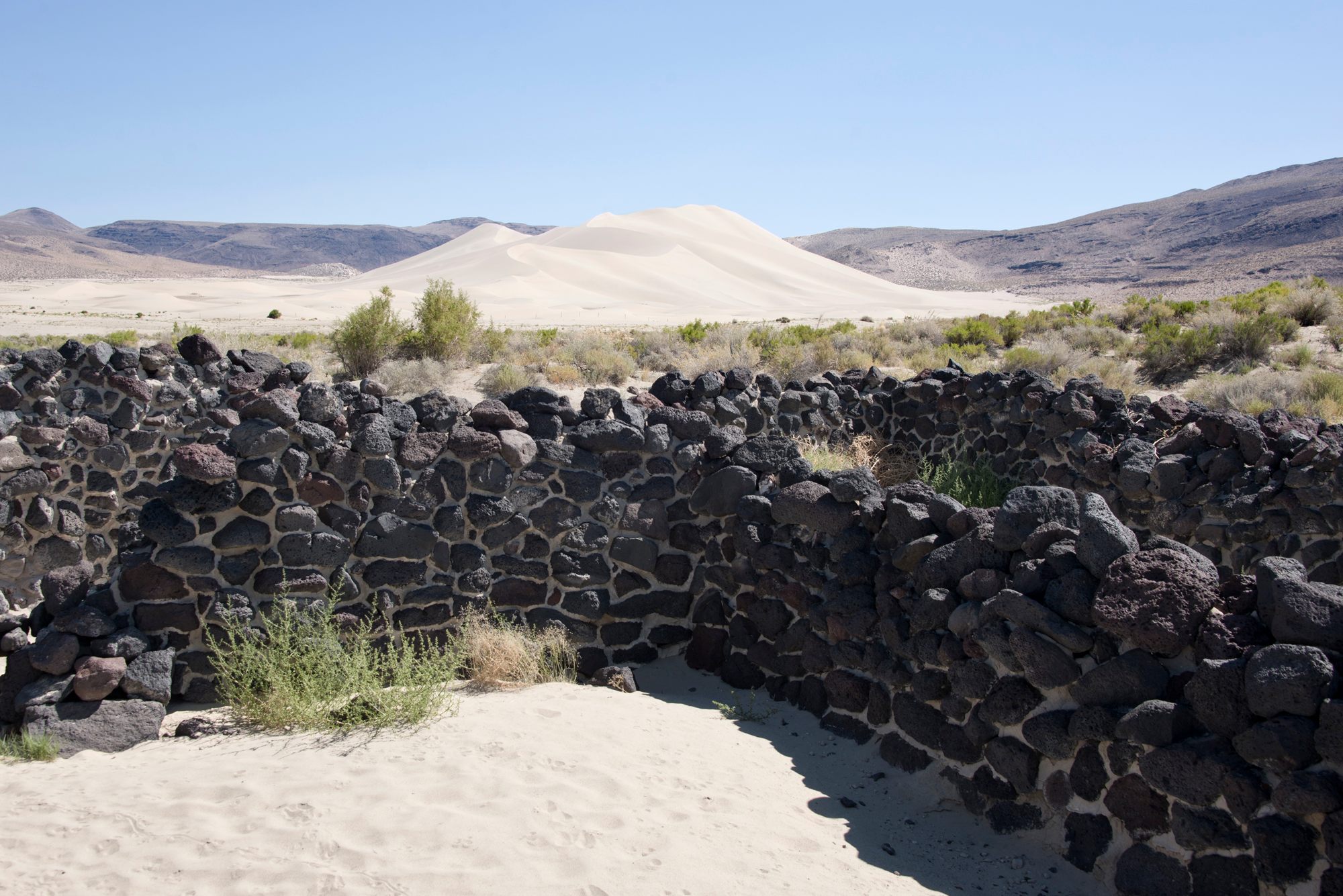Making Art in Extreme Conditions
How Pony Express ruins and singing sand dunes influenced day two of “The Fellowship of the Loneliest Road.”
On a stretch of Nevada’s Highway 50 just outside of Fallon, an enormous salt plain intersects with the asphalt. Just over 600 feet tall, Sand Mountain is one of only 30 or so desert locations worldwide classified as a “singing sand dune.” These natural phenomena occur as a result of the sand’s composition, moisture level, and kernel size, and they produce a low-pitched, ambient roar.
Paul Johnson set forth on the second day of his five-day journey across Nevada’s Highway 50, thanks to Atlas Obscura’s and TravelNevada’s The Fellowship of the Loneliest Road, intending to create an earthwork at Sand Mountain. On his way out of Fallon, he caught his first sight of the sand heaps that tower over Highway 50 like a massive roadblock funneled from the sky.
“I pulled off and walked a ways onto it and imagined being under 300 feet of water a few thousand short years ago during the last ice age,” he recounted in his travelogue from the day (the sand comes from Lake Lahontan, an ancient body of water that dried up nearly 9,000 years ago). “I’d learned the massive lake left visible shorelines on the mountainsides. I turned around and sure enough, there they were, like rings on a bathtub.”
When Johnson arrived at Sand Mountain, the usually sonorous sand dunes were relatively quiet. It was a windless day, and the temperature crept over 100 degrees Fahrenheit. As with every composition Johnson creates, the day’s conditions influenced its making and, ultimately, its final form.
As anyone who’s ever watched the making-of featurette of a stop-motion animation film knows, this particular type of photography demands a meticulously controlled environment. An unsteady hand can render dozens of frames unusable with the slightest brush. Unsurprisingly, Johnson has seen plenty of projects fall victim to wind, rain, or even an errant cloud suddenly blocking the sun.
Undisturbed by breeze, the sands seemed to be an opportune canvas for the day’s work. But as Johnson began work on an arrangement of large sticks, he found that the stillness of the salt plains was also a curse: the midday sun was creating a griddle of the earth, and Johnson was becoming overheated. Defeated by the temperature, he was forced to abandon the project.
Taking a much-needed break, he hiked to the nearby ruins of the Sand Springs Pony Express station.

In the mid-19th century, prospectors flocked west in search of precious metals and California was a brand new state with a rapidly growing population. The Civil War nearing, the United States was in dire need of a faster way to communicate with its westernmost territories.
The Pony Express was founded to address the need, promising the delivery of mail from Missouri to Sacramento in as few as ten days. Mounted horseman riding at a gallop replaced cumbersome stage coaches and, crucially, the 2000-mile route was served by 184 stations, each positioned less than 20 miles apart.
Hailed as a marvel, the Pony Express was ultimately short-lived. Only 19 months after it launched, the telegraph rendered it obsolete. Johnson could relate.
“The failed attempts are pretty frustrating,” he acknowledges.
But the day’s initial failure laid the foundation for a second work. After a restorative burger and beer at Middlegate Station (itself a former Pony Express stop), Johnson headed back to the salt plains. With daylight waning, he chose to use sturdy, basalt boulders: the same type of cobblestones he’d seen at the Pony Express station earlier that day.

Worried that footprints would betray his presence in the final animation, Johnson chose to create a shape that could also function as a platform where he could perch as he composed the scene. After assembling the circle, he stood in its center and pushed the boulders away, using them as literal stepping stones when he needed to exit to trip the shutter.
In the finished work, Johnson describes the cobblestones as “sort of bumbl[ing] together haphazardly and playfully.” The formation may look like a happy accident, but its creation wasn’t easy. Complications from the elements forced him to continuously reassess his work, eventually yielding a piece influenced by factors as diverse as the temperature of the sand and the history of the Pony Express.
Before he left the dunes, Johnson spotted another lone traveler walking along the sand’s ridges. Using a telephoto lens, he captured a surreal moment of a fellow explorer taking in the vastness of the surroundings.

Paul’s own work for the day finished, he threw a fistful of sand onto the rocks to cover his tracks.
This post is promoted in partnership with Travel Nevada. Head here to get started on your adventure.










Follow us on Twitter to get the latest on the world's hidden wonders.
Like us on Facebook to get the latest on the world's hidden wonders.
Follow us on Twitter Like us on Facebook